The document discusses an integrated approach to hematopathology for diagnosing leukemia and lymphoma, emphasizing the revised 2016 classification reflecting recent clinical and genetic insights. It highlights the advancements in treatment with targeted therapies, the importance of molecular diagnostics in risk stratification, and the need for cross-disciplinary collaboration in laboratory services. Various diagnostic techniques including cytogenetics, molecular testing, and flow cytometry are outlined for effective monitoring and treatment of these blood cancers.
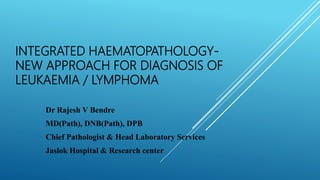

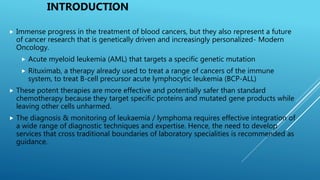









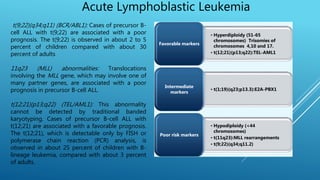



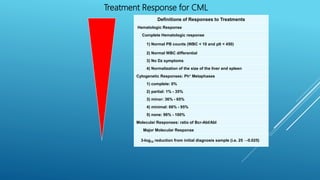





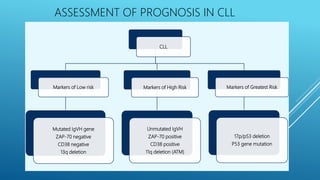










![MOLECULAR TECHNOLOGIES IN HEMATOLOGY
Molecular technique Applications Advantages
Fluorescence in situ
hybridization (FISH)
centromeric enumeration
probes (CEP), chromosome
painting probes, dual-color
dual fusion probes (D-FISH)
and dual-color break-apart
probes
• BCR to ABL gene at 9q34, t(9;22) variant in chronic myeloid
leukemia (CML) and acute promyelocytic leukemia (APL)
• demonstration of t(11;18)(q21;q21) in mucosa-associated
lymphoid tissue (MALT) lymphoma [6]; the detection of clonal
abnormalities (deleted 5q, trisomy 8 and monosomy 7) in
myelodysplastic syndromes (MDS) with minimal dysplasia; 11q23
abnormalities in acute myeloid leukemia (AML) [7]; the
demonstration of hyper- or hypo-diploidy and occult
translocations in acute lymphoid leukemia (ALL), which is hard to
grow in metaphase and is one of the difficulties of cytogenetic
detections [8]; myeloproliferative neoplasms (MPN) with
eosinophilia and interstitial deletion on short arm of chromosome
4; chronic lymphocytic leukemia (CLL) with trisomy 12 and cryptic
t(15;17) variant – ins(17;15) in APL](https://image.slidesharecdn.com/integratedhaematopathology-190217124030/85/Integrated-haematopathology-34-320.jpg)
![MOLECULAR TECHNOLOGIES IN HEMATOLOGY
Molecular technique Applications Advantages
Polymerase Chain Reaction
(PCR) & Various derivatives
RT-PCR, Q-PCR, multiplex
PCR, gap-PCR, ARMS and IS-
PCR
Unlike FISH, PCR and its
variants only detect
breakpoints covered by
designated specific primers
• Application of PCR include JAK2 V617F mutations; FLT3, NPM1,
and CEBPA mutations in acute myeloid leukemia with normal
cytogenetics (CN-AML) [11]; and gene rearrangements such as Ig
heavy chain gene rearrangement for B-cell malignancies and T-cell
receptor gamma chain gene rearrangement for T-cell malignancies
DNA Sequencing DNA sequencing is a post-
PCR analysis and a
confirmation method for
mutations.
• Applications include non-deleted α thalassaemia, F8 mutation in
HA, AML with normal karyotype, AML with NPM1 exon 12 mutation,
AML with mutated CEBPA (not common), FLT3 exon 14 tandem
duplication and other mutated genes – KIT, MLL, WT1, NRAS, KRAS;
and enquiries on normal or specific karyotypes
Massively parallel
or so called next generation
sequencing (NGS)
whole cancer genome
sequencing has revealed
novel candidate genes that
may contribute to leukemic
pathogenesis
• T-cell acute lymphoblastic leukemia (T-ALL), which is predominant
in male, the X-linked PHF6 gene was reported to be a tumor
suppressor gene
• AML with cryptic manifestation, driver mutations such as NPM1 and
CEBPA mutations in AML
• Potential markers include TP53 mutations in MDS and NOTCH1,
SF3B1 and BIRC3 mutations in CLL](https://image.slidesharecdn.com/integratedhaematopathology-190217124030/85/Integrated-haematopathology-35-320.jpg)

